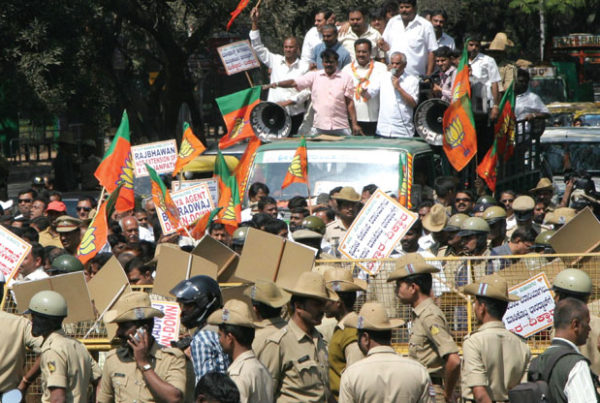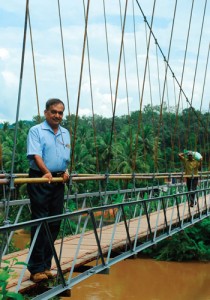Two Adivasis — supposed Naxals — are killed by police in a remote Orissa town. Sanjana Chappalli pens the only on-the-spot report from a land where the state dubs dissent as automatically Maoist. Photographs by Tarun Sehrawat
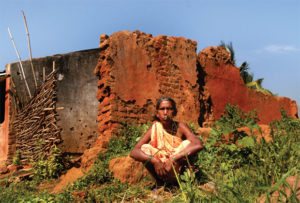 Vigil: A woman in Dombsil village sits before the wreckage of her house, destroyed by the CMAS
Vigil: A woman in Dombsil village sits before the wreckage of her house, destroyed by the CMASIF GIVEN a map and told this town’s name, chances are you’d find it difficult to spot. Devoted scrutiny would reveal, ultimately, a small two-street settlement in Orissa, about 500 km from the state capital Bhubaneswar, almost astride the border with Andhra Pradesh. There are tens of thousands of remote Indian towns like this but there is a good reason to take a closer look at Narayanpatna.
On the afternoon of November 20, the Indian Reserve Battalion, a paramilitary force stationed at Narayanpatna police station opened fire on 150 Adivasis who had gathered in front of the station. Two people, Wadeka Singanna and Andru Nachika, died; around 60 were injured. The victims were members of the Chasi Mulia Adivasi Sangh (CMAS), an Adivasi rights organisation working in Narayanpatna block.(interview with advisor to the CMAS) They were protesting against excesses committed by police and paramilitary forces that entered their villages during search and combing operations.
Narayanpatna block (in Orissa, a block is an administrative unit comprising several villages which falls under a tehsil) is a hilly tract of land on the Orissa-Andhra Pradesh border. Almost 90 percent of the 45,000 people who live in the block are Adivasis. For several years, according to the police, the block has witnessed violent attacks by Maoists – informers and contractors have been declared anti-people agents of the state and murdered with impunity and even police stations have been blown up. The November 20 firing, it is clear, took place in an extremely troubled land.
The reasons for the actual firing, however, are less clear. After travelling to the spot, TEHELKA discovered that even nine days after the incident, there was no consensus on the events of that day.
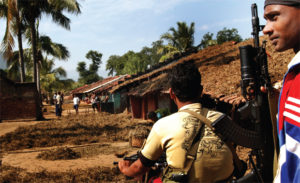 Cause for alarm: Seeing TEHELKA staffers, a 26-member Special Operations Group team starts search and combing operations in Basnaput village
Cause for alarm: Seeing TEHELKA staffers, a 26-member Special Operations Group team starts search and combing operations in Basnaput villageIn a press conference two days after the firing, SP Deepak Kumar laid out the official police version: leaders of CMAS broke down the police station gates and confronted Gaurang Sahu, the inspector in charge of the station. Heated arguments followed. At one point in the altercation, the Adivasis snatched a self loading assault rifle and opened fire. In all, 22 rounds were fired, claimed the SP and Sahu was shot in the leg. According to him, the police firing that killed the two CMAS leaders was in self-defence, in retaliation to the firing by the Adivasis.
However, senior district administration officials and a government-appointed lawyer who reached the town a few hours after the firing offered TEHELKA a different account of the day. Off the record, a medical staffer involved in the post-mortem said that the bullet injuries indicated that the two leaders had been shot from behind, along the spine. No bullet injuries were found on their legs, suggesting that the police were shooting to kill, not to incapacitate. Singanna, a key CMAS leader, was shot 14 times, with some of the shots being fired after he fell to the ground. When TEHELKA asked the medical staffer about the injuries sustained by Inspector Sahu, there was silence. In a feeble, nervous voice, he revealed that the injuries were by no means grievous. Ask if the examination of Inspector Sahu’s wounds showed signs of a bullet injury and the staffer tells TEHELKA he wants to be excused. He has a family that depends on him and would like to keep his job, he says. A constable at the police station who, too, refused to identify himself told TEHELKA that the injured inspector declined an offer to airlift him to Visakhapatnam, the nearest major city. The constable admitted, however, that that evening, Gaurang Sahu was limping around.
There are several other unanswered questions. If the Adivasis fired 22 rounds at the police and one bullet hit Sahu, where are the remaining bullets? In a relatively small police station compound, how did the Adivasis who were apparently firing indiscriminately manage to miss the other policemen and IRB forces? Who did they seize the weapon from? The altercation between the Adivasi leaders and the inspector took place in full public view in the station compound, between the gate and the station building. As the station sits on the junction of Narayanpatna’s two main roads, there were plenty of other eyewitnesses besides the CMAS members. Despite this, not one person talks of bullets fired from multiple locations. All accounts state that the bullets – 82 rounds were fired said SP Deepak Kumar at the press conference – came from the roof of the police station. The IRB personnel on the roof allegedly fired at the two leaders and then at the crowd. When TEHELKA contacted Gaurang Sahu, he refused to answer any questions.
THIS REFUSAL by the medical staffers and the police to come on record or even answer any questions is given some perspective when you consider what the Adivasis who were there that day say. Ranju Wadeka says, “We went to the police station to protest against their misbehaviour with women in Dumbagoda and Odipenta villages on November 18 and 19. When we reached the station, we demanded that the inspector in charge come out and talk with us. We waited for half an hour outside the station before four leaders walked through the open gate into the station compound to speak with the inspector. After a brief argument, as the leaders were leaving, the inspector yelled at the forces stationed on the roof to open fire. We saw them shooting down Singanna. After making sure he was not moving anymore, they turned their guns on us.” Ask Wadeka if the Adivasis were armed — even with hatchets or bows and arrows — and he laughs as he says, “If we wanted to kill the police, would we have walked to the police station? They frequently come to our villages for search operations. Wouldn’t it be easier to kill them there?”
The police have since arrested 63 Adivasis and launched a hunt for absconding CMAS leader Nachika Linga. Even as posters offering a reward for information about Linga flood Narayanpatna and the outlying villages, additional police and paramilitary forces have been moved in. With the Special Operations Group and the COBRA force monitoring all movement in the area, this once sleepy hamlet is now a war zone. A climate of fear blankets the entire region. In district headquarters Koraput, about 70 kilometres from Narayanpatna, the local taxi association told TEHELKA that the police had warned them against giving fares to outsiders. Of the six villages that TEHELKA visited in Narayanpatna block, several were deserted. The handful of Adivasi women who had stayed back said the other villagers had fled into the jungles, fearing police harassment and arrests.
IN BHALIAPUT, Linga’s village, ostensibly as “part of search operations” the forces burnt a portion of Linga’s house. When TEHELKA visited the village two days later, the three Adivasis who remained in the village said the police burnt the house after daubing it with enamel paint and dousing it in kerosene. A few metres away from the scorched debris, TEHELKA found tins of paint and an almost-empty kerosene bottle. Also strewn amidst the burnt debris were medicines which had been kept there for the village anganwadi centre, according to the Adivasis. In almost every house in the village, stored food grains had been destroyed by the forces.
THE INJURIES ON THE DEAD INDICATE THAT THE POLICE SHOT TO KILL, NOT TO INCAPACITATE
Beyond the questions that arise about police excesses, what is perhaps of greater concern is the campaign unleashed days after the firing. Two days after the firing on 20 November, the police dubbed CMAS a Maoist front. Two weeks later, they asked the Home Department to ban CMAS. Supporters of CMAS who attempted to travel to the region have been arrested and called Maoists. (One of the CMAS supporters arrested by the police is Tapan Kumar Mishra, a popular civil rights activist in Orissa. Mishra had even contested the 2009 Assembly elections as an independent candidate. Mishra was hooded and produced before the media.) The police also claimed to have recovered 150 Maoist uniforms, a powerful landmine, 2 kg of highly explosive material and a VHF communication system.
EYEWITNESSES AGREE THAT THE BULLETS CAME FROM THE POLICEMEN ON THE STATION ROOF
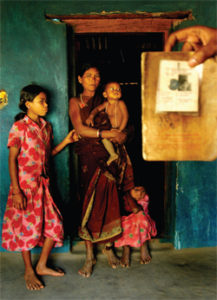 No news is bad news Families of Adivasi men picked up by the police await word of their loved ones
No news is bad news Families of Adivasi men picked up by the police await word of their loved onesBUT WHAT is the Chasi Mulia Adivasi Sangh? For more than 15 years, the CMAS has been working in Koraput district on two linked issues: the illegal and fraudulent grabbing of Adivasi land and alcohol addiction. With Adivasis’ rights over ancestral land and the prohibition of transfer of land to non- Scheduled Tribes recognised by the Orissa Scheduled Area Transfer of Immovable Property Act and the Orissa Land Regulations Act, the CMAS mobilised Adivasis to take back land that they claim has been unfairly appropriated by nontribals. Before the November 2009 firing, Adivasis told TEHELKA that over 2,000 acres of land had been reclaimed by CMAS.
However, rather than approach the courts or the revenue department for this reclamation, the CMAS in some cases did use violence. It destroyed the houses of non-tribals, including extremely poor Scheduled Caste families. As stories of attacks by CMAS activists spread, many Dalit families left villages of their own accord. TEHELKA met several families who had left for fear of CMAS attacks. Jihoya Kendruka – a man who was driven out of Domsil village by the CMAS told TEHELKA that in May 2009, clashes had broken out over CMAS’ attempts to reclaim land. Kendruka said the clashes left at least one dead and the houses of both CMAS members and those opposing them utterly destroyed.
The main force behind CMAS is Nachika Linga, currently on the police’s most wanted list. Several colourful stories of Linga abound. A man who escaped the shackles of slavery he had endured for 10 years from the time he was 6 years old. A man who used the story of his father’s alcoholism to motivate Adivasis to give up drinking and implement a liquor ban in all villages where the CMAS is active. A man who confronted an irregular anganwadi worker by seating her on a specially decorated cot and carrying her over 6 kilometres back to her house. A man the police say is currently hiding among the Maoists.
‘Only from an Adivasi village would the police abduct the elected representative’
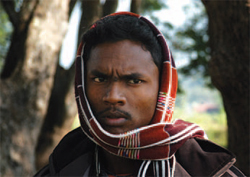 CHETAN MADI, 27
CHETAN MADI, 27
FATHER INDRA MADI was taken away on October 16, 2008. Has not been seen since. Habeas corpus petition filed in the Orissa High Court pending since December 2008.
A day after his father Indra Madi didn’t return home, panic gripped the family. It wasn’t usual for the sarpanch to stay away. It took Chetan and his family a whole day to piece together various accounts of eyewitnesses. His father was on his way home after dropping off a relative and the sarpanch of another village at her house. Between Tumsabadi village and his own, Tentuliguda, villagers say Indra was stopped by five plainclothes policemen on two motorbikes. A brief discussion later, Indra and his motorbike were taken away by the policemen. A fortnight earlier, Indra had petitioned the district collector regarding the case of a missing man from a neighbouring village. More than a year later, Chetan is determined to find his father. “Every time I go to the SP, he tells me my father was taken away by Naxalites. But the villagers recognise the policemen who took him away. My father was the sarpanch of the village, an elected government representative. Does the police care at all?” asks Chetan.
VOICES OF DEMOCRATIC PROTEST CAN EASILY BE SILENCED BY CALLING THEIR OWNERS MAOISTS
Interestingly, this isn’t the first time the CMAS has been accused of links with the Maoists. In June 2006, Linga and 3 other leaders were arrested and charged with being a front of the People’s War Group — which merged with the Maoist Communist Centre to form the Communist Party of India (Maoist) — and waging war against the State. The charges were examined and Linga and the CMAS were acquitted in a November 2007 judgment in which GC Panigrahi, Additional Sessions Judge at Jeypore called the CMAS “a silent political movement against exploitation of Adivasis… it has none of the trappings of waging war against the state…” The judge also cautioned against the unwarranted use of the term ‘Maoist’, saying that “in a democratic society, there is elbow room for all shades of opinion. In a democracy, holding meetings, giving public speeches, carrying flags etc. are all part of the game.”
AFTER GETTING ADIVASIS HOOKED ON ALCOHOL, THEIR LAND WAS GRABBED BY MONEYLENDERS
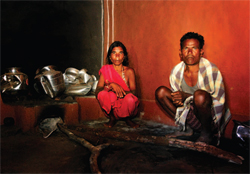 Empty vessels Even basic household utensils were crushed and broken by the CMAS
Empty vessels Even basic household utensils were crushed and broken by the CMASAlmost two years later, the charges have resurfaced. Vehement denials have come – even from the Maoists. The CPI (Maoist) says that while they support the CMAS, it is an independent organisation and there is no question of the CMAS or its leaders being part of the Maoists. In effect, the voices of organisations and individuals who agitate for their democratic rights are being silenced through the simple tactic of branding them Maoists. This practice is commonplace in neighbouring Chhattisgarh and Jharkhand, states that have emerged as ground zero in the State’s battle against Maoists. However, in Orissa, this tactic is unprecedented.
The Malkangiri Adivasi Sangh (MAS)— another Adivasi organisation fighting fraudulent land alienation — told TEHELKA that arbitrary arrests have become the order of the day in that district. “Like Koraput, the Maoists are active in this district too. We understand that the security forces have to do their work and arrest people behind the various Maoist attacks. But why terrorise innocent Adivasis who have no association with the Maoists?” asks Videsh Goud, a MAS activist who works in the Chitrakonda area of Malkangiri district. They maintain a detailed list of people who have been arrested by the police on charges of being Maoists. In May 2009, a fact-finding team that included the late Dr K Balagopal, VS Krishna and other members of the Andhra Pradesh Human Rights Forum also documented several cases of police excesses. TEHELKA travelled to three villages and spoke to seven families whose men had been taken away by the police and paramilitary forces.
‘Go tell the people in Delhi that if they behave like this with us, we will throw them out’
SON SADHURAM KHARA was taken away on 29 November 2009. Has no idea where he is now or who took him away. Three police stations in the area, including one across the border in Andhra, deny arresting or detaining his son.
26-year-old Sadhuram Khara was at the weekly Sunday haat with another relative when two people dressed in typical Adivasi clothes stopped him. Even as his relative listened openmouthed, the men asked Sadhuram if he spoke Telugu. When he said yes, they asked him to take his shirt off. As a frightened Sadhuram complied, the men asked him about the hair on his chest and his fit body. A minute later, Sadhuram was marched off as the relative took to his heels. People in the haat later told Jagannath Khara that the men who took his son away were from the Andhra Pradesh Greyhounds police. Says a weeping Jagannath, “In their mind, my son did not fit the profile of an Adivasi. But my son was young and worked in the fields. He knew Telugu since the border is so close. How can any of this be a crime?” Villagers talk of Sadhuram as a natural leader who helped people obtain NREGS job cards and other work in the village.
WHAT MAKES the situation in Malkangiri worse is the fact that the anti-Naxal Greyhounds of Andhra Pradesh carried out several arrests and illegal detentions with no prior intimation or coordination with the Orissa police. When TEHELKA spoke with Rajesh Chatria, inspector in charge of Chitrakonda police station, about the disappearance of an Adivasi, Sadhuram Khara from a village in his station limits, the inspector admitted that the local police were rarely informed about Greyhound activities. “The procedure is that the local police should be informed and that personnel from the local station should accompany the team. Any arrests should be recorded at the local police station,” says Chatria. He has no answers when it comes to Khara’s disappearance and promises to register a missing person’s complaint. A day after TEHELKA leaves Chitrakonda, Chatria turns Khara’s father away from the station.
In a world overrun by complexities, recognising that different languages of resistance can be spoken simultaneously is a requirement that receives inadequate attention. What is critical, however, is the official acceptance and recognition of the fact that some dialects of protest are not only legal but are basic components of a democratic polity. Instead, the state is dubbing all those who question it — including the Adivasis of remote Narayanpatna and Malkangiri — as Maoists.
Also read ‘We Reject The Maoist Line’, an interview with Gananath Patra, advisor to the CMAS
—
This article was originally published in Tehelka, a leading independent news magazine in India, known for its investigative journalism.


